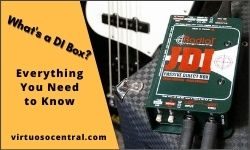So you are getting started into the world of sound systems, but don’t know what a DI box is? What does it do, or how to connect it in your set up? Well, you’ve come to the right place.
One of the most basic pieces of equipment used for audio is the DI Box. A DI box or direct box plays an important role when connecting different equipment to a mixing board, amplifier, or recording device. It helps to condition the incoming signal to get a clear sound.
It is one of the most essential tools in sound and something everyone should invest in. So what makes it so unique? Let’s start with the basics.
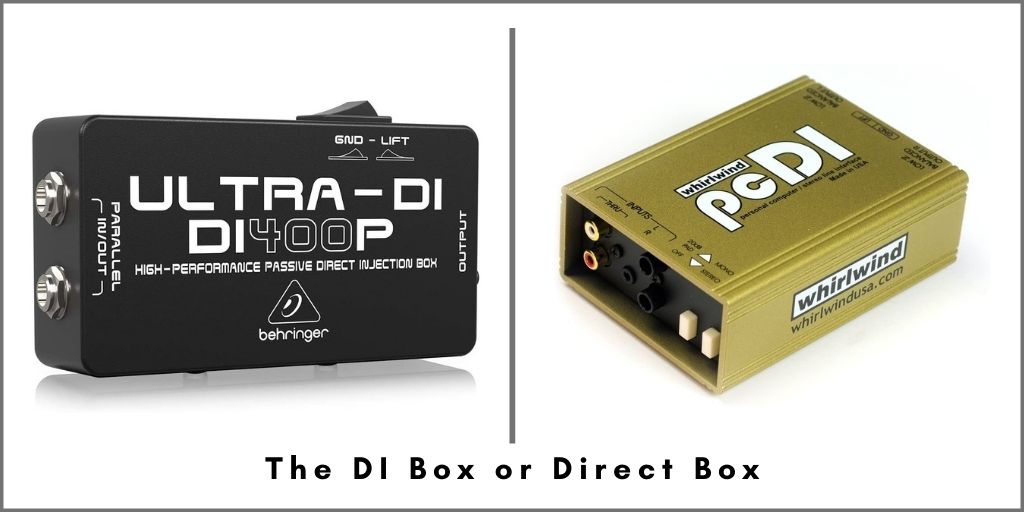
What is a DI Box?
A DI box is a device that takes a high impedance, unbalanced input signal and converts it to a low impedance, balanced output signal without degrading the signal itself.
DI stands for Direct Insertion, and it’s the type of input available in the direct box. The purpose of a direct insertion box is to take a two-conductor unbalanced line to convert it to a three-conductor balanced line. It also takes high impedance signals to change them to low impedance.
A DI box works to match the impedance and signal strength between two devices. That way, you get the best response possible from your instrument when connected to an audio mixer, digital audio recorder, or audio interface.
Just for clarification, in case you don’t know the concept, impedance refers to the resistance a circuit presents to an AC signal, and it’s represented by the letter “Z.” For example, the audio coming from an electric guitar is an AC signal. Examples of high impedance unbalanced signals (High Z) are electric guitars and electric bass.
What Does a DI Box Do?
You might be asking yourself, what is the point of using a DI box? Let me explain. As mentioned earlier, passive electric instruments only output high impedance unbalanced signals that are prone to picking up noise.
Cables with TS and RCA connectors are unbalanced and have the disadvantage that they act as an antenna. This means that they can introduce all kinds of noises to the sound signal, especially if the cable runs are long.
By using a DI box, your output signal becomes balanced and of low impedance. This is more advantageous because the sound can be sent using a three-conductor XLR cable, which is less vulnerable to picking up noise, delivering a cleaner signal.
Di boxes also prevent obnoxious noises that might ordinarily leak into sound equipment, like hums and buzzes. The direct input box is excellent for using it in the recording studio because it isolates the sound from being prone to picking up noise.
The Types of DI Boxes
The DI Box comes in two very different forms, passive and active. Both have their pros and cons. Let’s take a look at each one.
Passive Direct Box
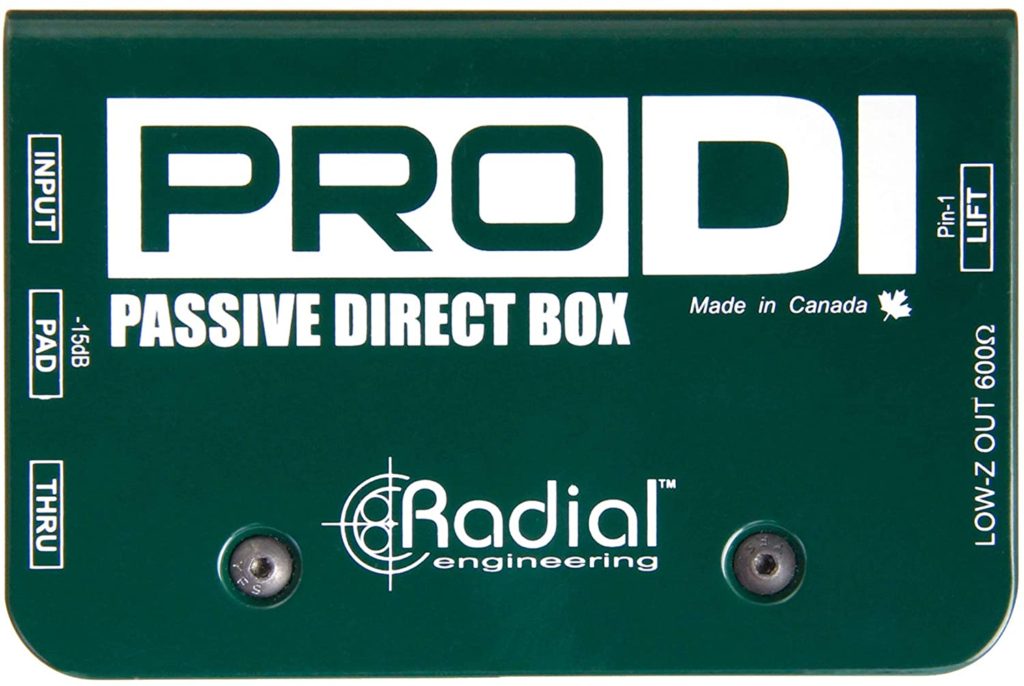
Passive DI boxes use a balum transformer when going through the process of changing the sound from high-impedance and low-impedance.
A passive direct box also doesn’t require a power source. It doesn’t even so much as need batteries to operate. That also means it’s a fairly basic piece of equipment that can easily be managed but doesn’t contain a ton of incredible features.
If an instrument has a strong output, such as active guitars, bass, or keyboards, then it should be paired with a passive DI. Overall, a passive DI box is the more common form of direct box because it’s relatively inexpensive. That, and because they are very durable.
Here are a few examples of some of the best passive DI boxes available today (links to Amazon).
- Radial Pro DI
- Whirlwind IMP 2
- Behringer Ultra-DI DI400P
- Samson MD1
- Radial ProD2 – Stereo Passive DI Box
- Samson MD2 Pro – Stereo Passive DI Box
Active DI box
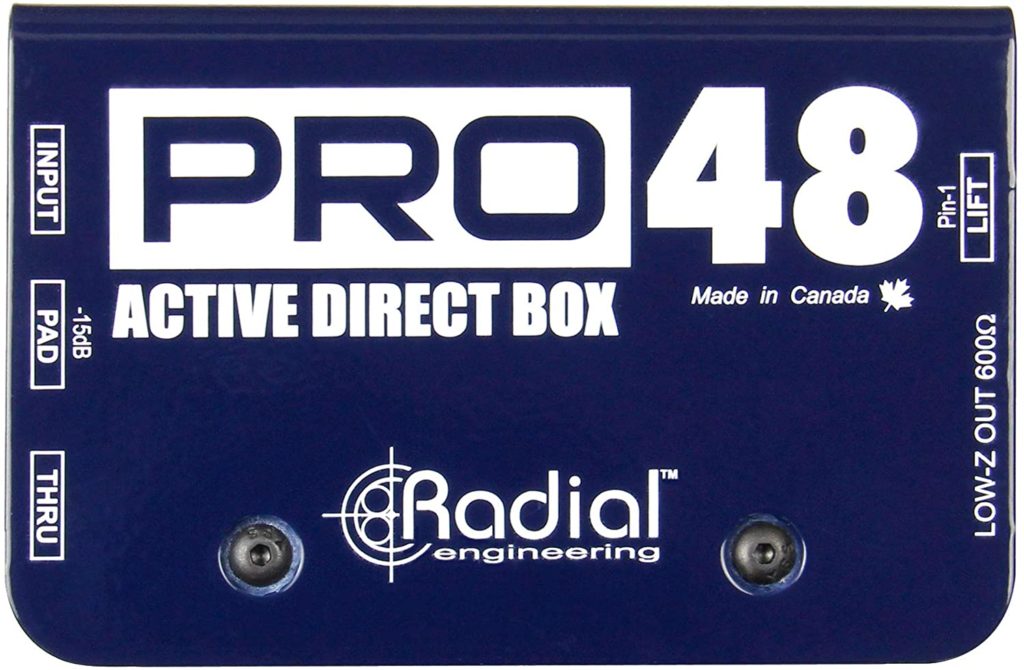
The major difference between passive and active is simple: an active DI box uses a preamplifier. This amplifier basically turns a weak signal into a strong signal, thus making it easier to work with.
Active direct boxes require power. Typically a 9V battery or 48V phantom power provided by the mixing console. If using the provided phantom power from the mixer, this voltage will be supplied by the XLR cable that goes from the mixer to the DI box.
If an output is weak, such as the signal coming from a passive electric guitar, or bass, this is the direct box you’re going to need. As it will boost the weak signal as well as convert it from unbalanced into balanced, making it sound clear and strong, even if the output isn’t.
Active DI boxes are more expensive than others because they use more electronic components to achieve their purpose.
These are examples of some of the best active DI boxes available in the market today (links to Amazon)
- Radial Pro48 – Requires 48V Phantom Power
- Radial J48 MK2 – Requires 48V Phantom Power
- Behringer Ultra-DI DI100 – Battery or Phantom Powered
- Samson MDA1 – Battery or Phantom Powered
- Mackie MDB-1A – Stereo DI Box – Requires 48V Phantom Power
Features to Look for in a DI Box
Input/Output Channels
One major thought to consider when buying a DI box is the number of input/output channels you’d need.
If you plan to connect a single channel instrument such as a guitar or bass, then a single-channel DI box is enough. If instead, you need to connect stereo signals like your keyboard, laptop, and tablet, a multi-channel direct box is required.
Throughput – Thru/Bypass
The Throughput on a direct input box is used to split the input signal through a 1/4 inch TS connector. The sound can then be amplified onstage as well as sent backstage to a PA system. It separates the sound and plays it in two (and sometimes more) places at once. Not all DI boxes have this, so it’s something to consider when looking them over.
A good example of when this comes handy is when a guitar player needs to send the signal to the main mixing console but also needs to connect the guitar to the onstage guitar amp. In such a case having the thru/bypass option, it’s ideal.
Ground Lift
Though one of the main purposes of the DI box is to remove signal noise, sometimes ground loops become a severe problem in the setup. By having a ground lift switch on the direct box, this problem can be solved as the ground lift helps remove the hum caused by the AC power line on the XLR cable.
Pad
PAD stands for Passive Attenuation Device, and as its name implies, the PAD function in a DI box reduces the level of a signal. In some cases, a signal’s strength is too high. If it’s connected to the audio mixer or digital audio recorder without attenuating it, the resulting sound will be distorted and not clear.
By activating the PAD switch, the signal strength is reduced by a fixed amount, usually between -10dB and -20dB.
This function is convenient, especially if connecting active instruments like a keyboard, active guitar, or active bass.
Polarity Reverse
Polarity reverse, also known as phasing, allows you to reverse pin 2 and pin 3 in the XLR cable by the flip of a switch. This function can be used as a recording technique to add signals that are out of phase, producing an interesting sound, especially for electric guitars.
In some cases, polarity reverse can also become handy when playing live on stage as it can help in reducing feedback.
Frequently Asked Questions About Direct Boxes
How to Use a Direct Box for Keyboard?
Many keyboards don’t have balanced connections, and most use unbalanced TS outputs, which tend to introduce noise to the signal.
When you need to connect the keyboard to an audio mixer, amplifier, or recording device, it’s always recommended to use balanced XLR or TRS connectors. That way, your signal’s strength is matched for better results.
This is where a multi-channel DI box, such as the Radial ProD2 Passive 2 Channel Direct Box is necessary for your setup. That way, you covert the unbalanced signal coming out of the keyboard to a balanced one going to the mixer or recording system.
The reason you want to use a multi-channel direct box is that keyboard signals are stereo (Left and Right channel).
To use a direct box for connecting a keyboard is straightforward. All you have to do is connect signal cables from the output of the keyboard to the input of the direct box. Then from the output of the DI box, run XLR cables to the input channels in the mixer, amp, or recording device.
The diagram below can be used as a reference for the setup.
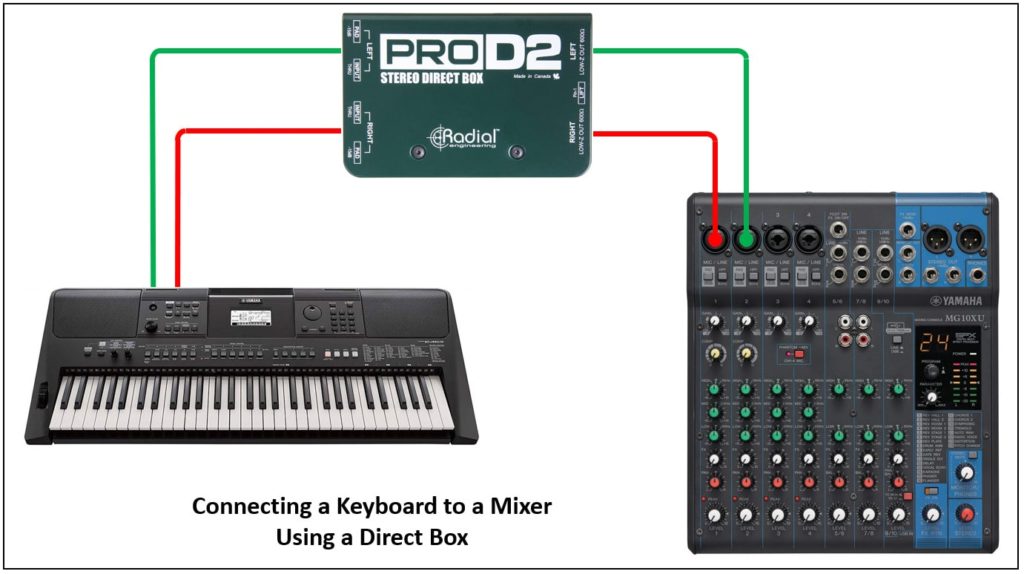
How to Connect a DI Box to an Amp?
There are instances where you need to connect a DI box to an amp. An example would be if you need to send a guitar signal to a mixing console but also need to send the same signal to the guitar amp.
In such a case, all you have to do is connect the guitar to the “Input” of the direct box. Then use another cable to connect from the output labeled “THRU or BYPASS” to the input of the amplifier. The balanced output (XLR) is the one that goes to the mixer or recording device.
Follow the connection diagram below to visualize the process.
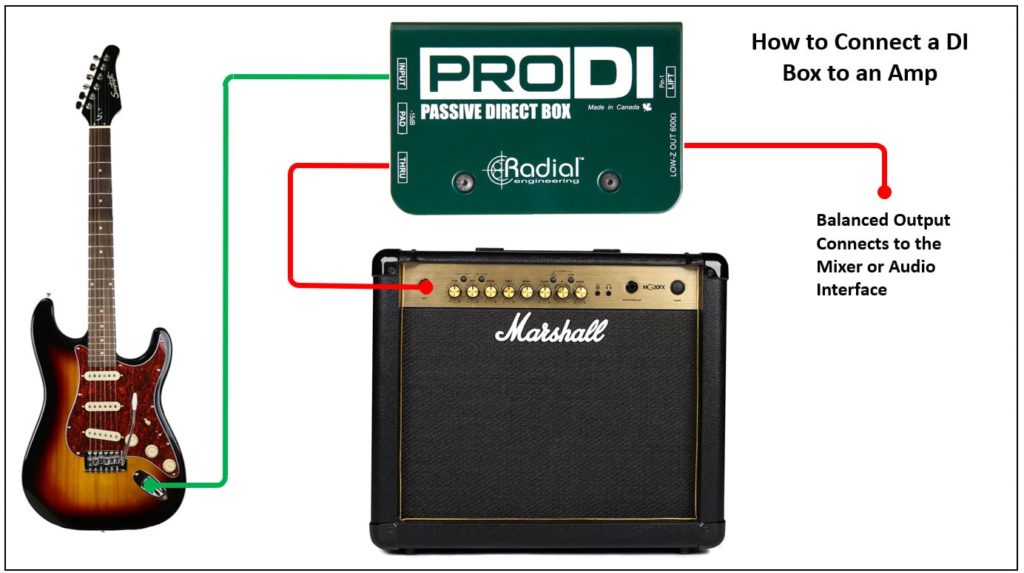
What is the Best Way to Connect an Electric Guitar to a Mixer?
The best way to connect an electric guitar to a mixer is by using a DI box. This principle applies to any electric instrument that doesn’t have balanced outputs such as bass, electronic drums, keyboards, etc.
All you have to do is connect your guitar to the input of the direct box. Then, from the balanced output connector (XLR), attach an XLR cable to the input channel of the mixing console.
Just remember that unbalanced connections are of high impedance, decreasing the signal gain. Plus, by using them to connect the electric guitar to the audio mixers or interfaces, you could create signal unbalances due to impedance mismatches. This is why the best way to connect an electric guitar to a mixer is by using a DI box/direct box.
Here is an example of one of the best DI boxes for connecting an electric guitar to a mixer, the Radial Pro DI Passive Direct Box (link to Amazon).
I have included a diagram below for your reference to make it easier to visualize the connection procedure.
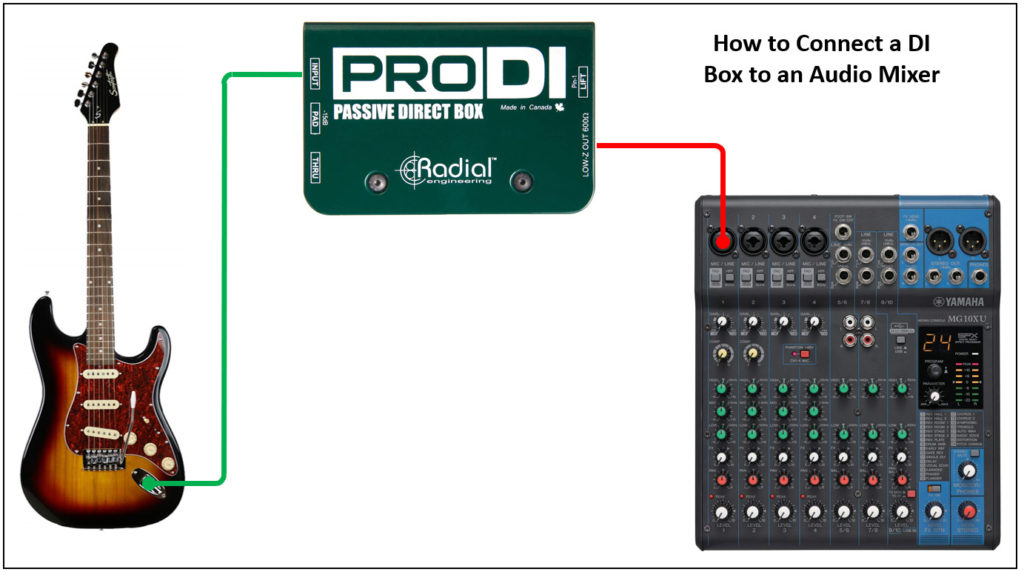
Does a DI Box Reduce Noise?
Yes, DI boxes can help in reducing external noises, but if the noise is coming from the signal itself due to a ground loop, then they don’t help much. For instance, if you have a ground loop noise coming from your guitar or amplifier signal, this noise will also be noticeable on the output of the direct box.
To get rid of a ground loop hum or buzz from a signal, you need to break the ground loop. Most direct boxes come with a “ground lift” switch, which is intended for breaking the ground loop noise in your signal.
In most cases, by just flipping the ground loop switch, the hum goes away. Still, there are instances where it is more complicated to eliminate the ground loop buzz.
In such a case, the best and easiest solution is to use an inline ground loop isolator such as the IceCube IC-1 Line Hum Eliminator (link to Amazon) as it will filter the 50-60Hz buzz from the sound signal.
The inline ground loop isolator should be connected before the signal goes to the audio mixer or amplifier. I have included a diagram for your reference; check it out below.
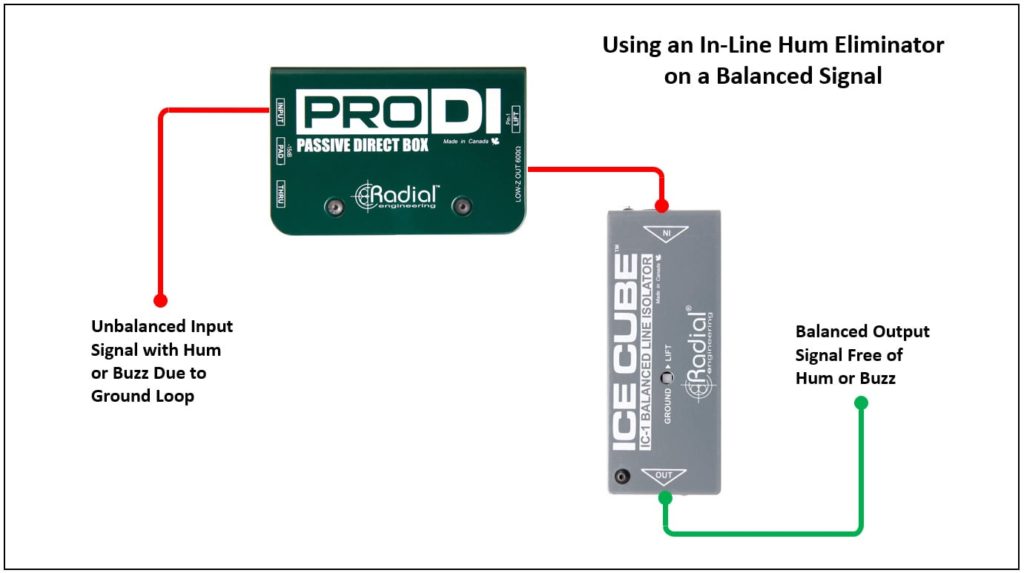
Final Thoughts
Now that you’ve learned what a DI box is, what it’s used for, and all the features to look out for in one, it’s time to enter the world of sound and get a DI box for yourself. You won’t regret it.
